Corporate Accounting and Reporting Assignment: Impairment Analysis
VerifiedAdded on 2020/04/01
|10
|1937
|69
Homework Assignment
AI Summary
This assignment delves into the critical aspects of corporate accounting and reporting, with a specific focus on asset impairment. The introduction provides an overview of impairment accounting, referencing both IAS 36 and AS 28, and emphasizes the importance of regularly assessing tangible and intangible assets for potential write-downs. The assignment explores the identification of impairment indicators, differentiating between internal and external factors, and the calculation of recoverable value, which is the higher of the value in use and fair value less costs of disposal. The assignment also discusses the concept of Cash Generating Units (CGUs) and their significance in impairment testing. The solution section provides a detailed analysis of a case study involving Gali Limited, demonstrating the allocation of impairment loss across various assets, including goodwill, plant, equipment, and fittings. The conclusion stresses the importance of judgment, estimates, and proper disclosures in financial statements, including the basis of impairment, loss recognition, and any reversals. The assignment provides the journal entry to effect the impairment loss. The reference section provides citations to support the assignment.

Paraphrase This Document
Need a fresh take? Get an instant paraphrase of this document with our AI Paraphraser
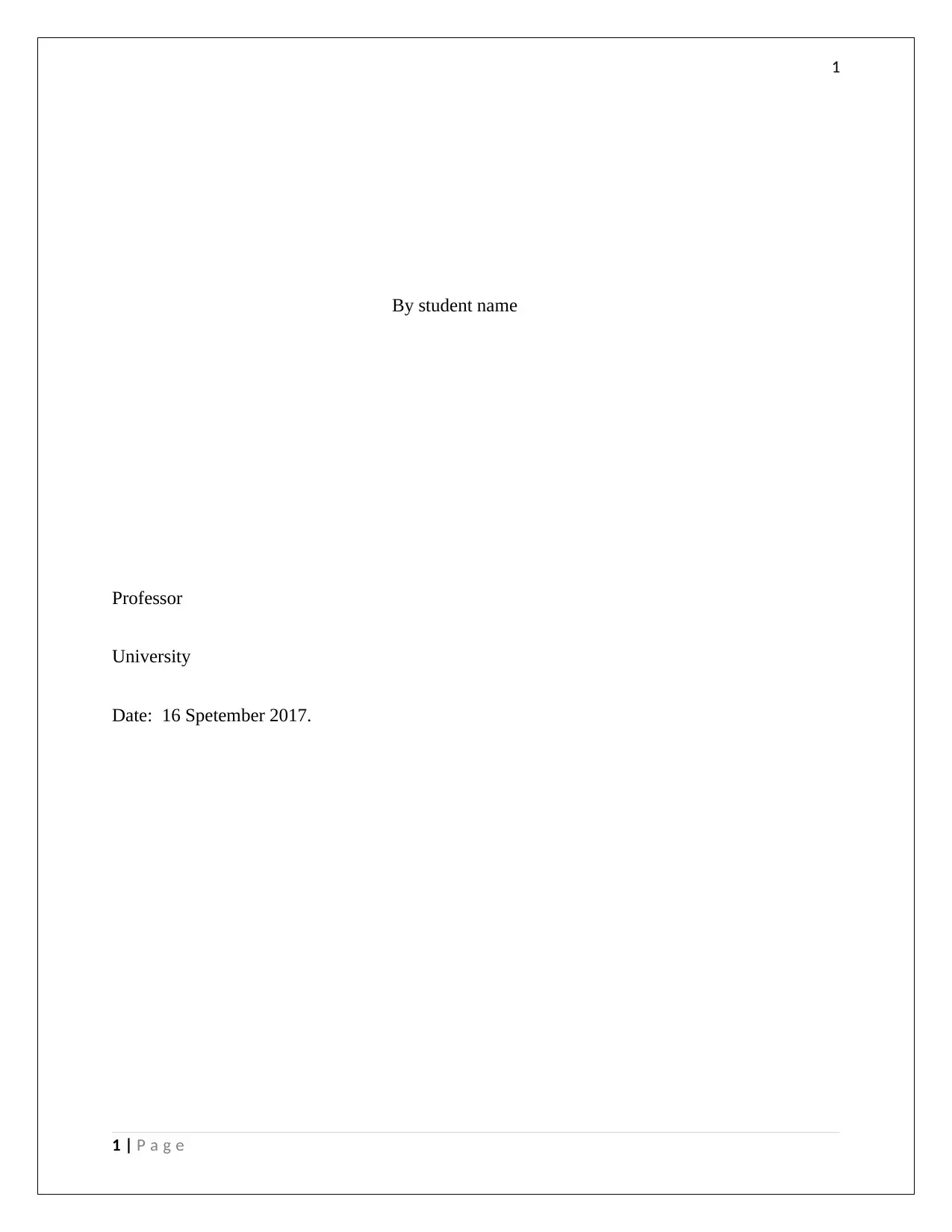
1
By student name
Professor
University
Date: 16 Spetember 2017.
1 | P a g e
By student name
Professor
University
Date: 16 Spetember 2017.
1 | P a g e
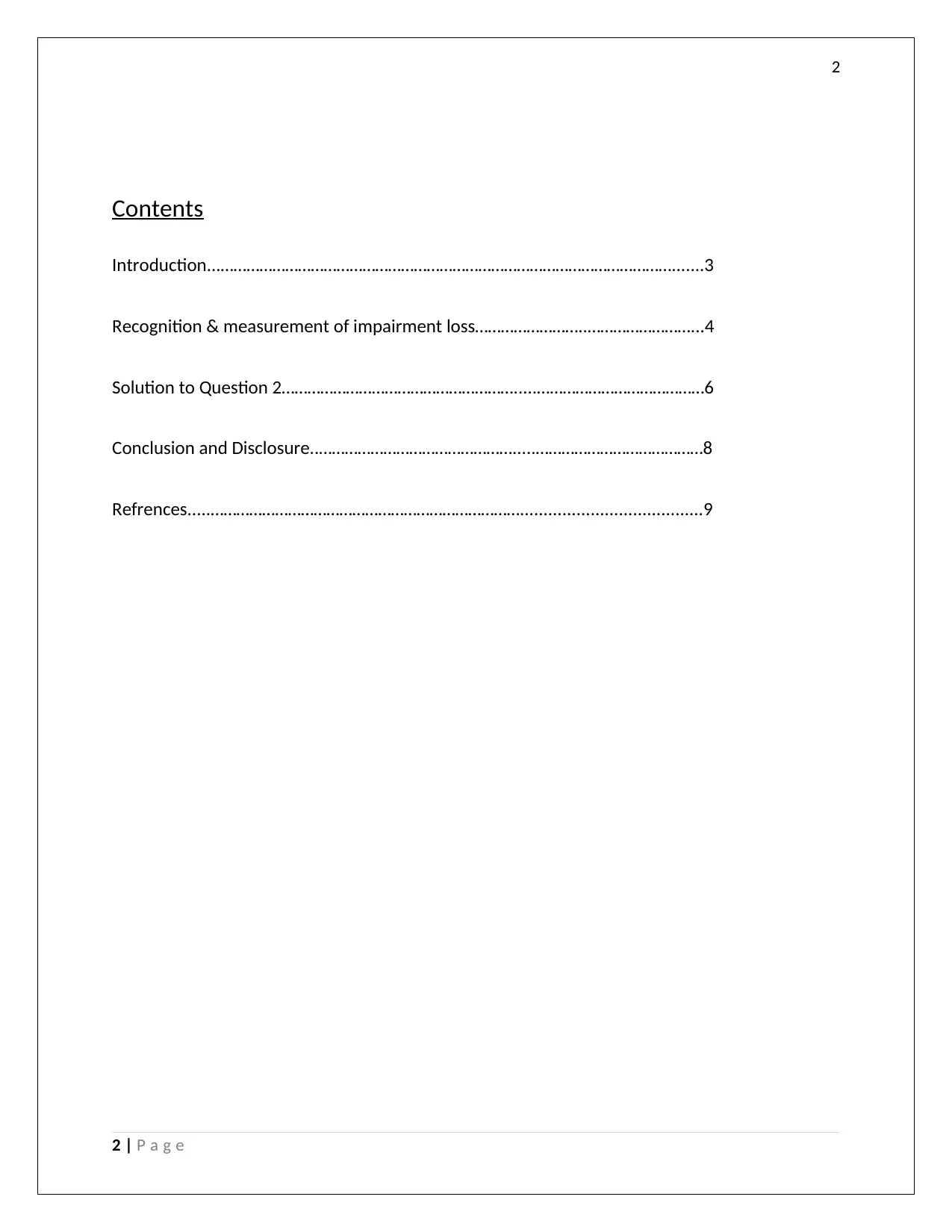
2
Contents
Introduction...…………………………………………………………………………………………….......3
Recognition & measurement of impairment loss……………………..……………………...4
Solution to Question 2……………………………………………….....…………………………………6
Conclusion and Disclosure..……………………………………….....…………………………………8
Refrences.....……………………………………………………………….......................................9
2 | P a g e
Contents
Introduction...…………………………………………………………………………………………….......3
Recognition & measurement of impairment loss……………………..……………………...4
Solution to Question 2……………………………………………….....…………………………………6
Conclusion and Disclosure..……………………………………….....…………………………………8
Refrences.....……………………………………………………………….......................................9
2 | P a g e
⊘ This is a preview!⊘
Do you want full access?
Subscribe today to unlock all pages.

Trusted by 1+ million students worldwide
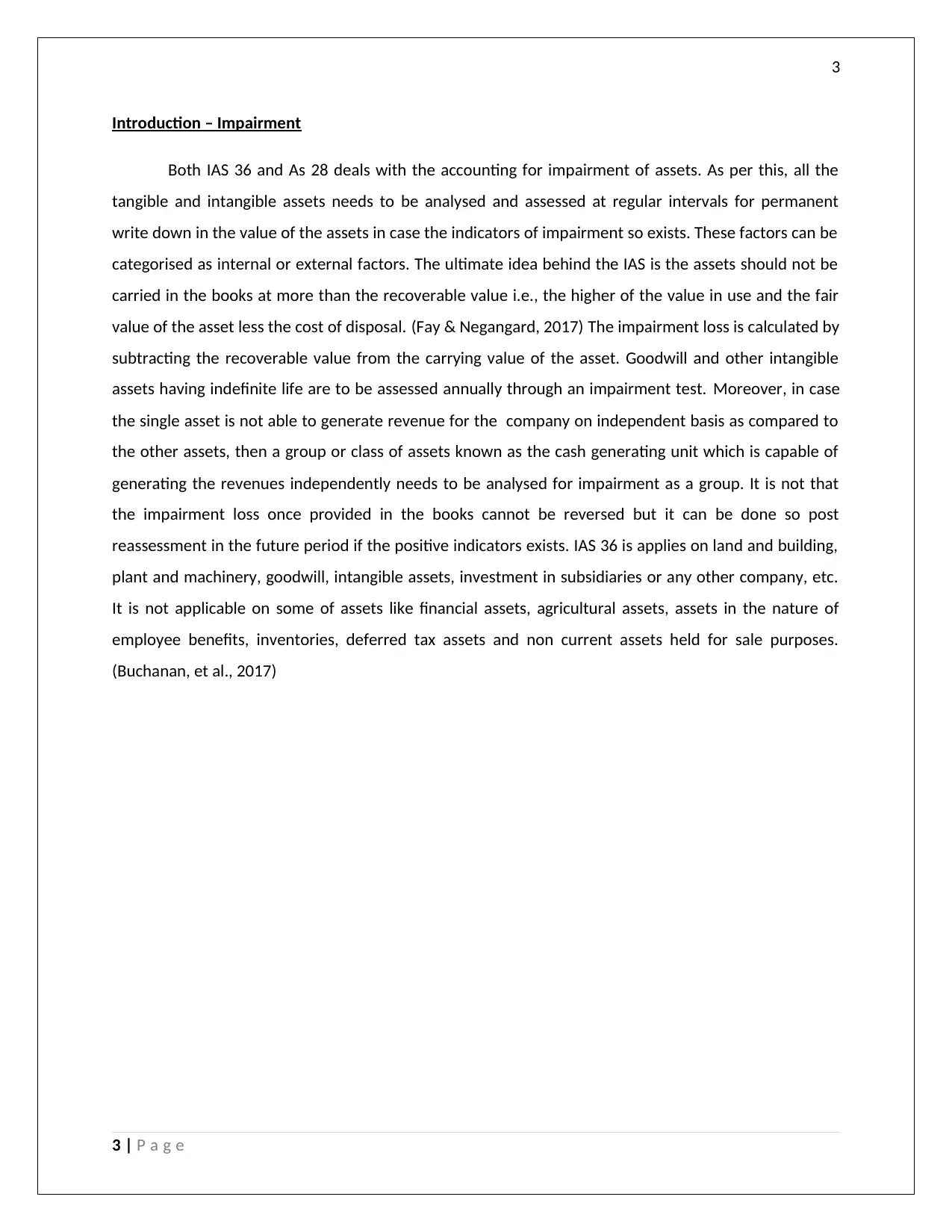
3
Introduction – Impairment
Both IAS 36 and As 28 deals with the accounting for impairment of assets. As per this, all the
tangible and intangible assets needs to be analysed and assessed at regular intervals for permanent
write down in the value of the assets in case the indicators of impairment so exists. These factors can be
categorised as internal or external factors. The ultimate idea behind the IAS is the assets should not be
carried in the books at more than the recoverable value i.e., the higher of the value in use and the fair
value of the asset less the cost of disposal. (Fay & Negangard, 2017) The impairment loss is calculated by
subtracting the recoverable value from the carrying value of the asset. Goodwill and other intangible
assets having indefinite life are to be assessed annually through an impairment test. Moreover, in case
the single asset is not able to generate revenue for the company on independent basis as compared to
the other assets, then a group or class of assets known as the cash generating unit which is capable of
generating the revenues independently needs to be analysed for impairment as a group. It is not that
the impairment loss once provided in the books cannot be reversed but it can be done so post
reassessment in the future period if the positive indicators exists. IAS 36 is applies on land and building,
plant and machinery, goodwill, intangible assets, investment in subsidiaries or any other company, etc.
It is not applicable on some of assets like financial assets, agricultural assets, assets in the nature of
employee benefits, inventories, deferred tax assets and non current assets held for sale purposes.
(Buchanan, et al., 2017)
3 | P a g e
Introduction – Impairment
Both IAS 36 and As 28 deals with the accounting for impairment of assets. As per this, all the
tangible and intangible assets needs to be analysed and assessed at regular intervals for permanent
write down in the value of the assets in case the indicators of impairment so exists. These factors can be
categorised as internal or external factors. The ultimate idea behind the IAS is the assets should not be
carried in the books at more than the recoverable value i.e., the higher of the value in use and the fair
value of the asset less the cost of disposal. (Fay & Negangard, 2017) The impairment loss is calculated by
subtracting the recoverable value from the carrying value of the asset. Goodwill and other intangible
assets having indefinite life are to be assessed annually through an impairment test. Moreover, in case
the single asset is not able to generate revenue for the company on independent basis as compared to
the other assets, then a group or class of assets known as the cash generating unit which is capable of
generating the revenues independently needs to be analysed for impairment as a group. It is not that
the impairment loss once provided in the books cannot be reversed but it can be done so post
reassessment in the future period if the positive indicators exists. IAS 36 is applies on land and building,
plant and machinery, goodwill, intangible assets, investment in subsidiaries or any other company, etc.
It is not applicable on some of assets like financial assets, agricultural assets, assets in the nature of
employee benefits, inventories, deferred tax assets and non current assets held for sale purposes.
(Buchanan, et al., 2017)
3 | P a g e
Paraphrase This Document
Need a fresh take? Get an instant paraphrase of this document with our AI Paraphraser
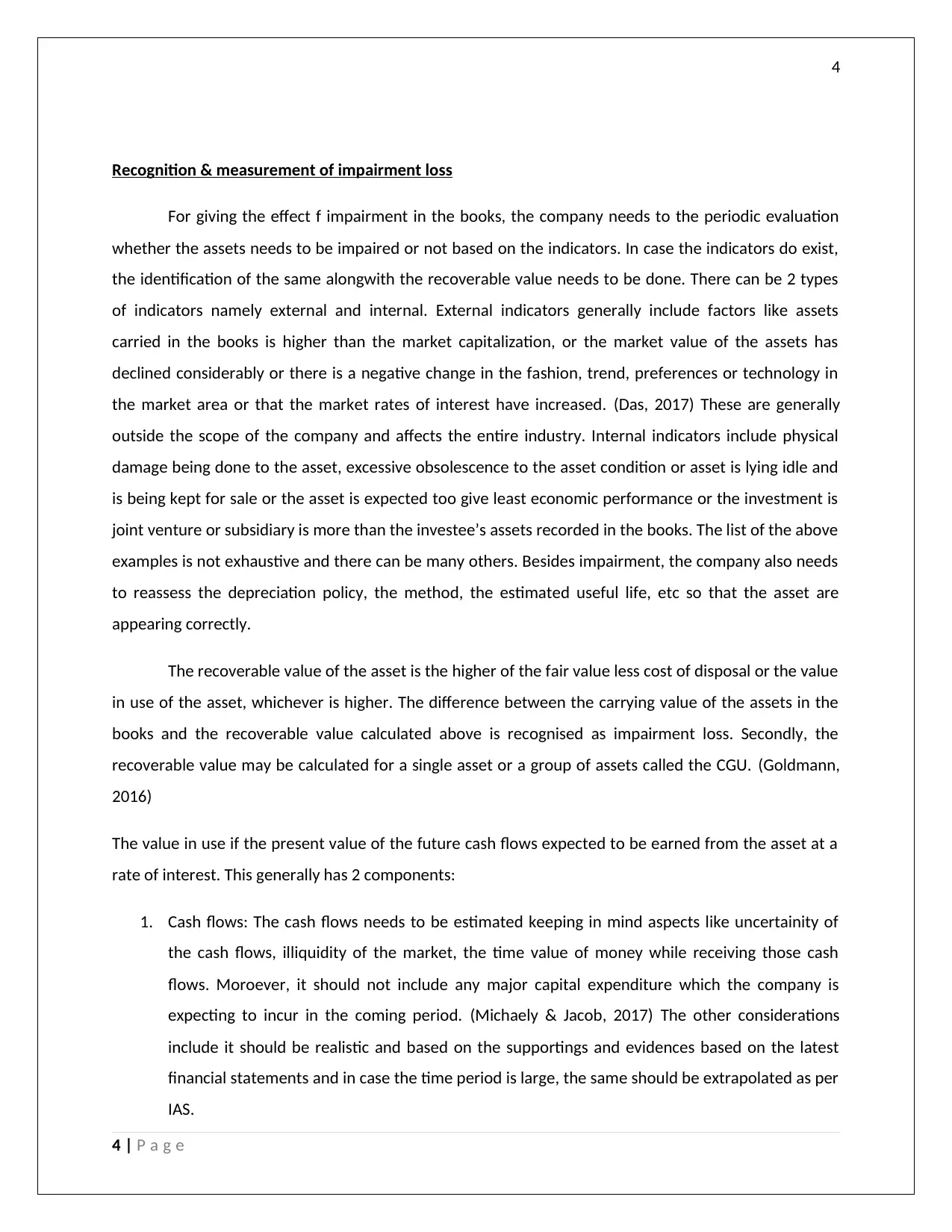
4
Recognition & measurement of impairment loss
For giving the effect f impairment in the books, the company needs to the periodic evaluation
whether the assets needs to be impaired or not based on the indicators. In case the indicators do exist,
the identification of the same alongwith the recoverable value needs to be done. There can be 2 types
of indicators namely external and internal. External indicators generally include factors like assets
carried in the books is higher than the market capitalization, or the market value of the assets has
declined considerably or there is a negative change in the fashion, trend, preferences or technology in
the market area or that the market rates of interest have increased. (Das, 2017) These are generally
outside the scope of the company and affects the entire industry. Internal indicators include physical
damage being done to the asset, excessive obsolescence to the asset condition or asset is lying idle and
is being kept for sale or the asset is expected too give least economic performance or the investment is
joint venture or subsidiary is more than the investee’s assets recorded in the books. The list of the above
examples is not exhaustive and there can be many others. Besides impairment, the company also needs
to reassess the depreciation policy, the method, the estimated useful life, etc so that the asset are
appearing correctly.
The recoverable value of the asset is the higher of the fair value less cost of disposal or the value
in use of the asset, whichever is higher. The difference between the carrying value of the assets in the
books and the recoverable value calculated above is recognised as impairment loss. Secondly, the
recoverable value may be calculated for a single asset or a group of assets called the CGU. (Goldmann,
2016)
The value in use if the present value of the future cash flows expected to be earned from the asset at a
rate of interest. This generally has 2 components:
1. Cash flows: The cash flows needs to be estimated keeping in mind aspects like uncertainity of
the cash flows, illiquidity of the market, the time value of money while receiving those cash
flows. Moroever, it should not include any major capital expenditure which the company is
expecting to incur in the coming period. (Michaely & Jacob, 2017) The other considerations
include it should be realistic and based on the supportings and evidences based on the latest
financial statements and in case the time period is large, the same should be extrapolated as per
IAS.
4 | P a g e
Recognition & measurement of impairment loss
For giving the effect f impairment in the books, the company needs to the periodic evaluation
whether the assets needs to be impaired or not based on the indicators. In case the indicators do exist,
the identification of the same alongwith the recoverable value needs to be done. There can be 2 types
of indicators namely external and internal. External indicators generally include factors like assets
carried in the books is higher than the market capitalization, or the market value of the assets has
declined considerably or there is a negative change in the fashion, trend, preferences or technology in
the market area or that the market rates of interest have increased. (Das, 2017) These are generally
outside the scope of the company and affects the entire industry. Internal indicators include physical
damage being done to the asset, excessive obsolescence to the asset condition or asset is lying idle and
is being kept for sale or the asset is expected too give least economic performance or the investment is
joint venture or subsidiary is more than the investee’s assets recorded in the books. The list of the above
examples is not exhaustive and there can be many others. Besides impairment, the company also needs
to reassess the depreciation policy, the method, the estimated useful life, etc so that the asset are
appearing correctly.
The recoverable value of the asset is the higher of the fair value less cost of disposal or the value
in use of the asset, whichever is higher. The difference between the carrying value of the assets in the
books and the recoverable value calculated above is recognised as impairment loss. Secondly, the
recoverable value may be calculated for a single asset or a group of assets called the CGU. (Goldmann,
2016)
The value in use if the present value of the future cash flows expected to be earned from the asset at a
rate of interest. This generally has 2 components:
1. Cash flows: The cash flows needs to be estimated keeping in mind aspects like uncertainity of
the cash flows, illiquidity of the market, the time value of money while receiving those cash
flows. Moroever, it should not include any major capital expenditure which the company is
expecting to incur in the coming period. (Michaely & Jacob, 2017) The other considerations
include it should be realistic and based on the supportings and evidences based on the latest
financial statements and in case the time period is large, the same should be extrapolated as per
IAS.
4 | P a g e
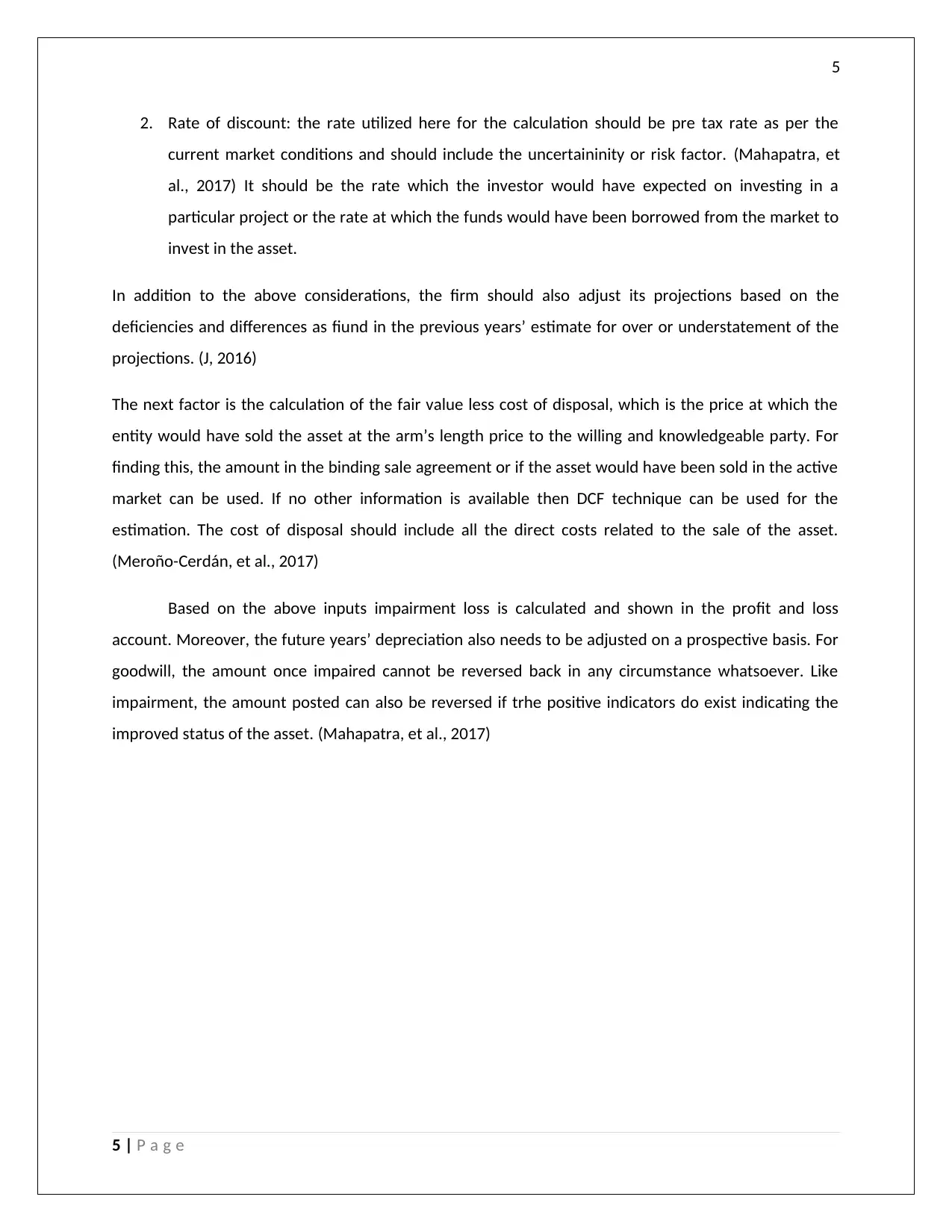
5
2. Rate of discount: the rate utilized here for the calculation should be pre tax rate as per the
current market conditions and should include the uncertaininity or risk factor. (Mahapatra, et
al., 2017) It should be the rate which the investor would have expected on investing in a
particular project or the rate at which the funds would have been borrowed from the market to
invest in the asset.
In addition to the above considerations, the firm should also adjust its projections based on the
deficiencies and differences as fiund in the previous years’ estimate for over or understatement of the
projections. (J, 2016)
The next factor is the calculation of the fair value less cost of disposal, which is the price at which the
entity would have sold the asset at the arm’s length price to the willing and knowledgeable party. For
finding this, the amount in the binding sale agreement or if the asset would have been sold in the active
market can be used. If no other information is available then DCF technique can be used for the
estimation. The cost of disposal should include all the direct costs related to the sale of the asset.
(Meroño-Cerdán, et al., 2017)
Based on the above inputs impairment loss is calculated and shown in the profit and loss
account. Moreover, the future years’ depreciation also needs to be adjusted on a prospective basis. For
goodwill, the amount once impaired cannot be reversed back in any circumstance whatsoever. Like
impairment, the amount posted can also be reversed if trhe positive indicators do exist indicating the
improved status of the asset. (Mahapatra, et al., 2017)
5 | P a g e
2. Rate of discount: the rate utilized here for the calculation should be pre tax rate as per the
current market conditions and should include the uncertaininity or risk factor. (Mahapatra, et
al., 2017) It should be the rate which the investor would have expected on investing in a
particular project or the rate at which the funds would have been borrowed from the market to
invest in the asset.
In addition to the above considerations, the firm should also adjust its projections based on the
deficiencies and differences as fiund in the previous years’ estimate for over or understatement of the
projections. (J, 2016)
The next factor is the calculation of the fair value less cost of disposal, which is the price at which the
entity would have sold the asset at the arm’s length price to the willing and knowledgeable party. For
finding this, the amount in the binding sale agreement or if the asset would have been sold in the active
market can be used. If no other information is available then DCF technique can be used for the
estimation. The cost of disposal should include all the direct costs related to the sale of the asset.
(Meroño-Cerdán, et al., 2017)
Based on the above inputs impairment loss is calculated and shown in the profit and loss
account. Moreover, the future years’ depreciation also needs to be adjusted on a prospective basis. For
goodwill, the amount once impaired cannot be reversed back in any circumstance whatsoever. Like
impairment, the amount posted can also be reversed if trhe positive indicators do exist indicating the
improved status of the asset. (Mahapatra, et al., 2017)
5 | P a g e
⊘ This is a preview!⊘
Do you want full access?
Subscribe today to unlock all pages.

Trusted by 1+ million students worldwide
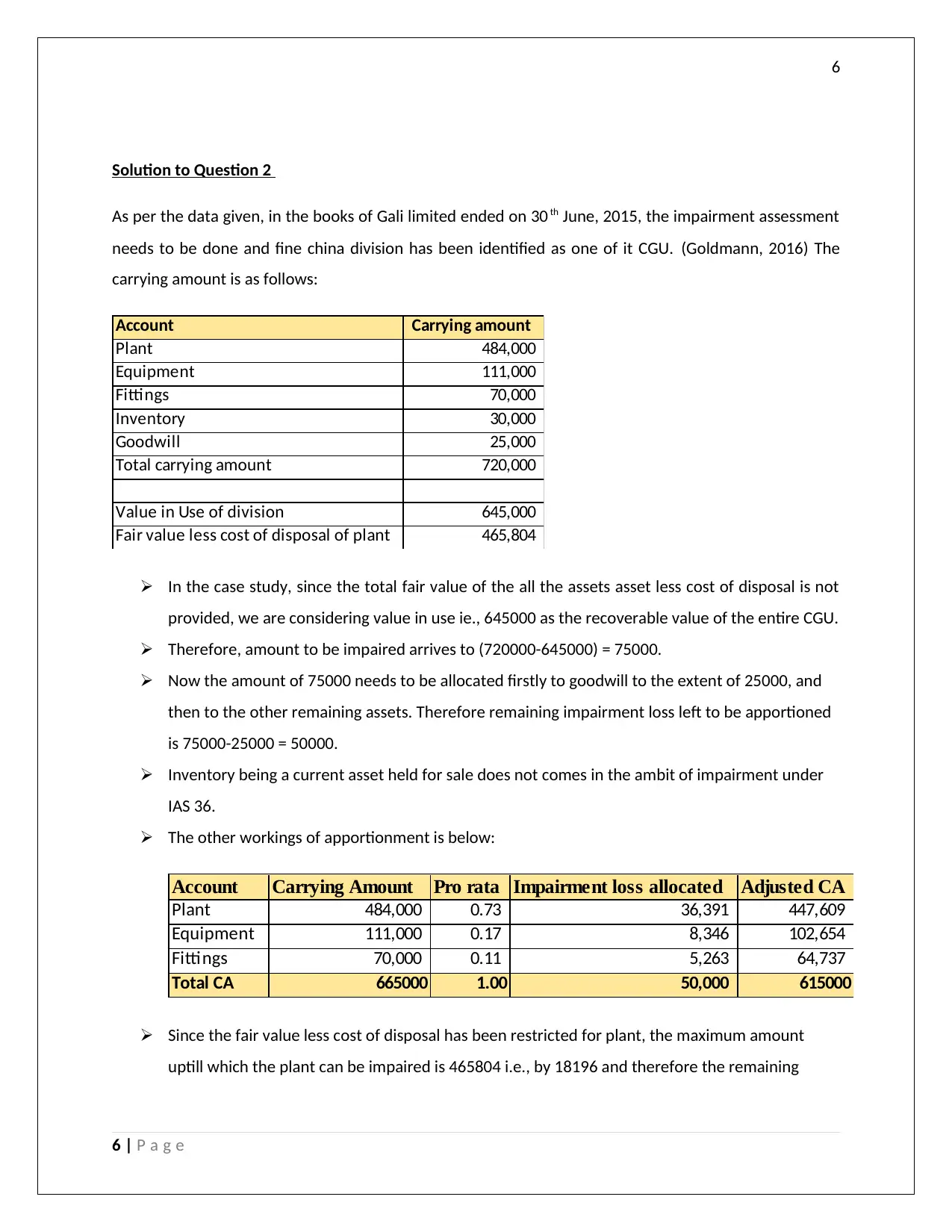
6
Solution to Question 2
As per the data given, in the books of Gali limited ended on 30 th June, 2015, the impairment assessment
needs to be done and fine china division has been identified as one of it CGU. (Goldmann, 2016) The
carrying amount is as follows:
Account Carrying amount
Plant 484,000
Equipment 111,000
Fittings 70,000
Inventory 30,000
Goodwill 25,000
Total carrying amount 720,000
Value in Use of division 645,000
Fair value less cost of disposal of plant 465,804
In the case study, since the total fair value of the all the assets asset less cost of disposal is not
provided, we are considering value in use ie., 645000 as the recoverable value of the entire CGU.
Therefore, amount to be impaired arrives to (720000-645000) = 75000.
Now the amount of 75000 needs to be allocated firstly to goodwill to the extent of 25000, and
then to the other remaining assets. Therefore remaining impairment loss left to be apportioned
is 75000-25000 = 50000.
Inventory being a current asset held for sale does not comes in the ambit of impairment under
IAS 36.
The other workings of apportionment is below:
Account Carrying Amount Pro rata Impairment loss allocated Adjusted CA
Plant 484,000 0.73 36,391 447,609
Equipment 111,000 0.17 8,346 102,654
Fittings 70,000 0.11 5,263 64,737
Total CA 665000 1.00 50,000 615000
Since the fair value less cost of disposal has been restricted for plant, the maximum amount
uptill which the plant can be impaired is 465804 i.e., by 18196 and therefore the remaining
6 | P a g e
Solution to Question 2
As per the data given, in the books of Gali limited ended on 30 th June, 2015, the impairment assessment
needs to be done and fine china division has been identified as one of it CGU. (Goldmann, 2016) The
carrying amount is as follows:
Account Carrying amount
Plant 484,000
Equipment 111,000
Fittings 70,000
Inventory 30,000
Goodwill 25,000
Total carrying amount 720,000
Value in Use of division 645,000
Fair value less cost of disposal of plant 465,804
In the case study, since the total fair value of the all the assets asset less cost of disposal is not
provided, we are considering value in use ie., 645000 as the recoverable value of the entire CGU.
Therefore, amount to be impaired arrives to (720000-645000) = 75000.
Now the amount of 75000 needs to be allocated firstly to goodwill to the extent of 25000, and
then to the other remaining assets. Therefore remaining impairment loss left to be apportioned
is 75000-25000 = 50000.
Inventory being a current asset held for sale does not comes in the ambit of impairment under
IAS 36.
The other workings of apportionment is below:
Account Carrying Amount Pro rata Impairment loss allocated Adjusted CA
Plant 484,000 0.73 36,391 447,609
Equipment 111,000 0.17 8,346 102,654
Fittings 70,000 0.11 5,263 64,737
Total CA 665000 1.00 50,000 615000
Since the fair value less cost of disposal has been restricted for plant, the maximum amount
uptill which the plant can be impaired is 465804 i.e., by 18196 and therefore the remaining
6 | P a g e
Paraphrase This Document
Need a fresh take? Get an instant paraphrase of this document with our AI Paraphraser
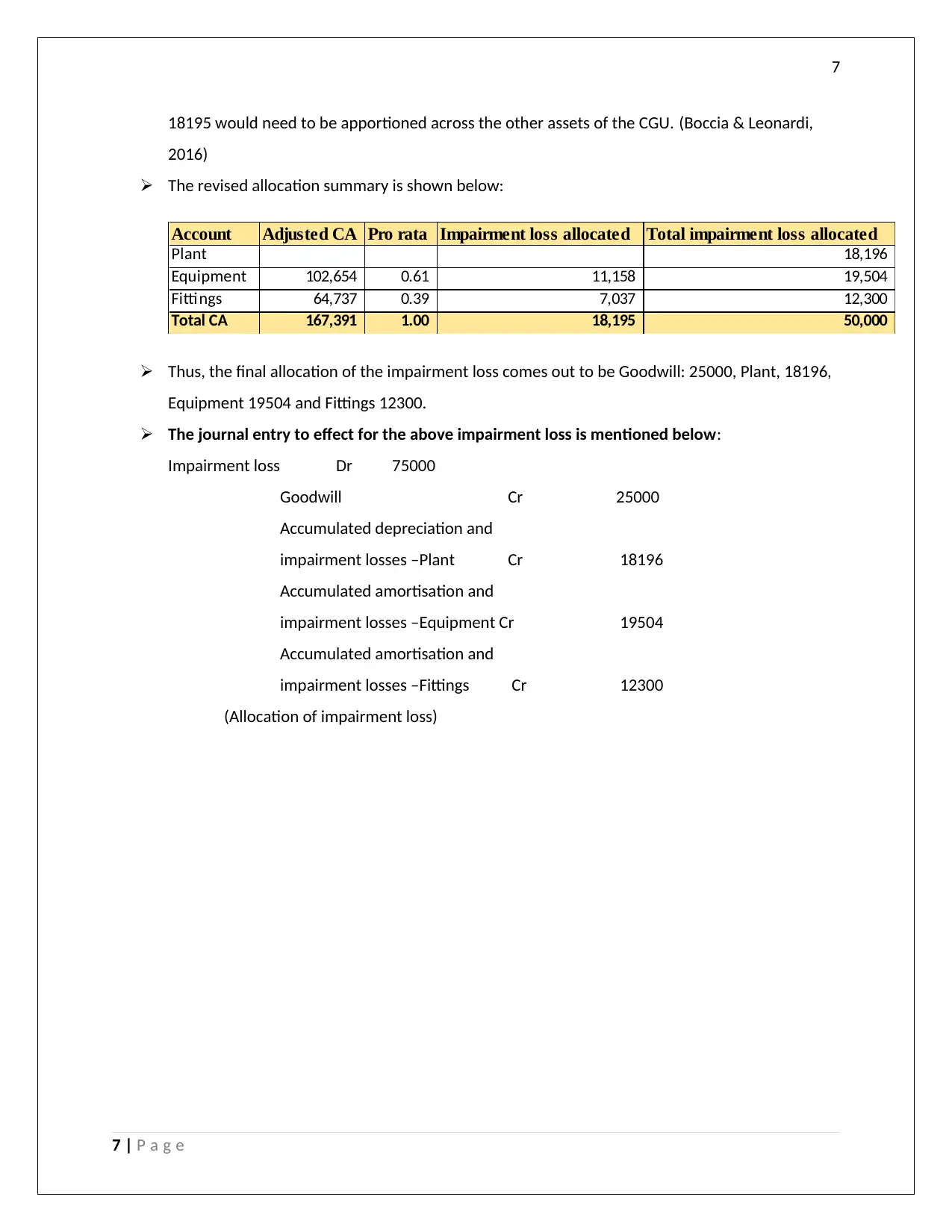
7
18195 would need to be apportioned across the other assets of the CGU. (Boccia & Leonardi,
2016)
The revised allocation summary is shown below:
Account Adjusted CA Pro rata Impairment loss allocated Total impairment loss allocated
Plant 18,196
Equipment 102,654 0.61 11,158 19,504
Fittings 64,737 0.39 7,037 12,300
Total CA 167,391 1.00 18,195 50,000
Thus, the final allocation of the impairment loss comes out to be Goodwill: 25000, Plant, 18196,
Equipment 19504 and Fittings 12300.
The journal entry to effect for the above impairment loss is mentioned below:
Impairment loss Dr 75000
Goodwill Cr 25000
Accumulated depreciation and
impairment losses –Plant Cr 18196
Accumulated amortisation and
impairment losses –Equipment Cr 19504
Accumulated amortisation and
impairment losses –Fittings Cr 12300
(Allocation of impairment loss)
7 | P a g e
18195 would need to be apportioned across the other assets of the CGU. (Boccia & Leonardi,
2016)
The revised allocation summary is shown below:
Account Adjusted CA Pro rata Impairment loss allocated Total impairment loss allocated
Plant 18,196
Equipment 102,654 0.61 11,158 19,504
Fittings 64,737 0.39 7,037 12,300
Total CA 167,391 1.00 18,195 50,000
Thus, the final allocation of the impairment loss comes out to be Goodwill: 25000, Plant, 18196,
Equipment 19504 and Fittings 12300.
The journal entry to effect for the above impairment loss is mentioned below:
Impairment loss Dr 75000
Goodwill Cr 25000
Accumulated depreciation and
impairment losses –Plant Cr 18196
Accumulated amortisation and
impairment losses –Equipment Cr 19504
Accumulated amortisation and
impairment losses –Fittings Cr 12300
(Allocation of impairment loss)
7 | P a g e
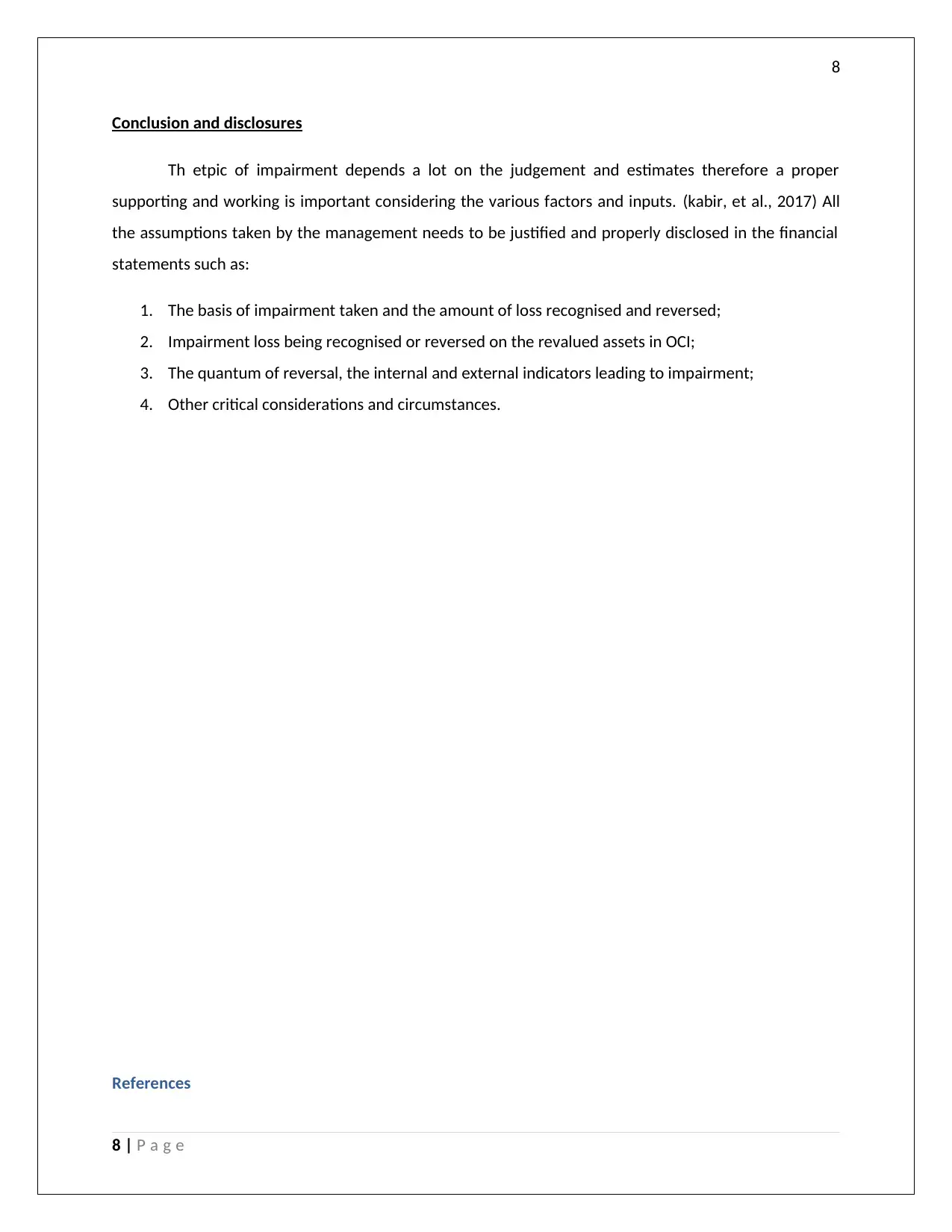
8
Conclusion and disclosures
Th etpic of impairment depends a lot on the judgement and estimates therefore a proper
supporting and working is important considering the various factors and inputs. (kabir, et al., 2017) All
the assumptions taken by the management needs to be justified and properly disclosed in the financial
statements such as:
1. The basis of impairment taken and the amount of loss recognised and reversed;
2. Impairment loss being recognised or reversed on the revalued assets in OCI;
3. The quantum of reversal, the internal and external indicators leading to impairment;
4. Other critical considerations and circumstances.
References
8 | P a g e
Conclusion and disclosures
Th etpic of impairment depends a lot on the judgement and estimates therefore a proper
supporting and working is important considering the various factors and inputs. (kabir, et al., 2017) All
the assumptions taken by the management needs to be justified and properly disclosed in the financial
statements such as:
1. The basis of impairment taken and the amount of loss recognised and reversed;
2. Impairment loss being recognised or reversed on the revalued assets in OCI;
3. The quantum of reversal, the internal and external indicators leading to impairment;
4. Other critical considerations and circumstances.
References
8 | P a g e
⊘ This is a preview!⊘
Do you want full access?
Subscribe today to unlock all pages.

Trusted by 1+ million students worldwide
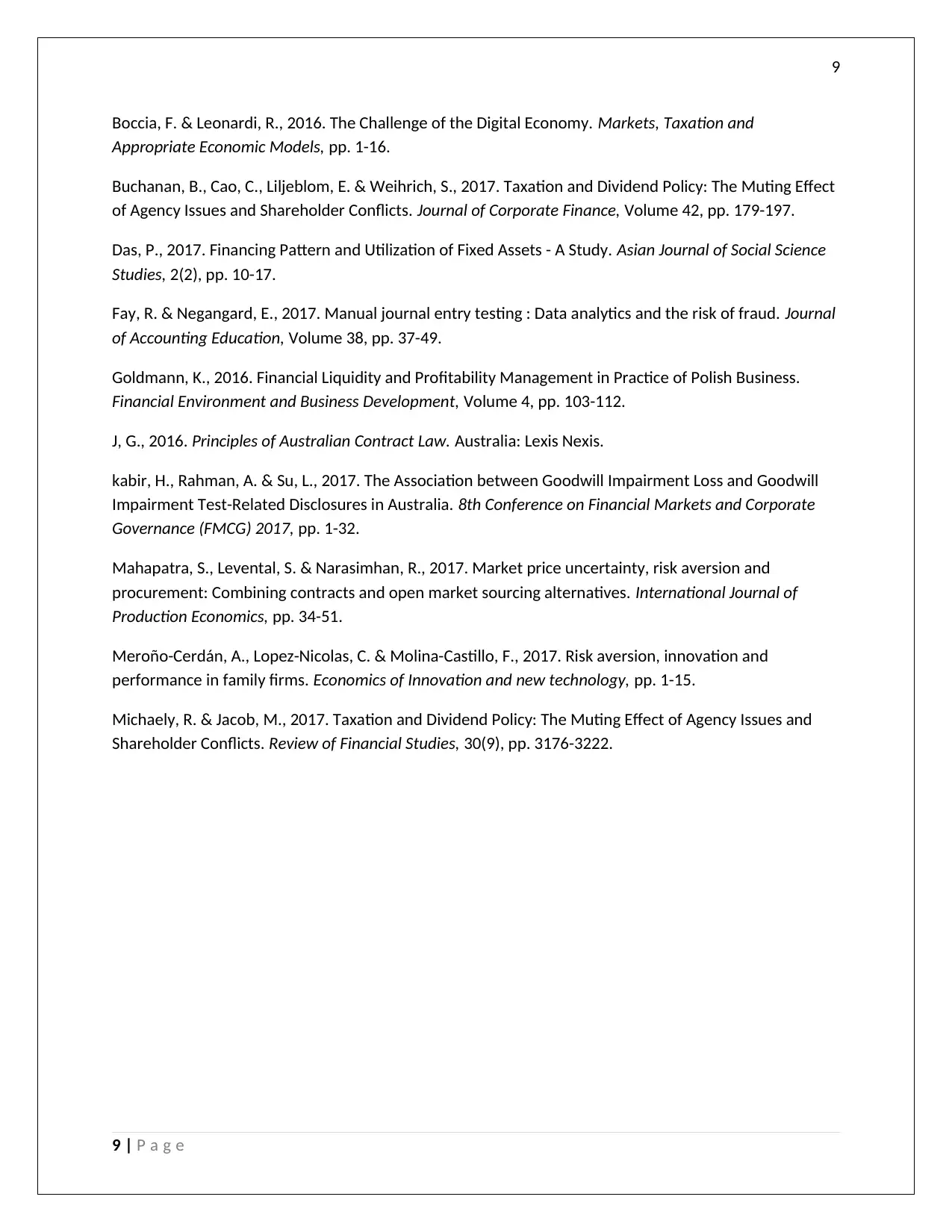
9
Boccia, F. & Leonardi, R., 2016. The Challenge of the Digital Economy. Markets, Taxation and
Appropriate Economic Models, pp. 1-16.
Buchanan, B., Cao, C., Liljeblom, E. & Weihrich, S., 2017. Taxation and Dividend Policy: The Muting Effect
of Agency Issues and Shareholder Conflicts. Journal of Corporate Finance, Volume 42, pp. 179-197.
Das, P., 2017. Financing Pattern and Utilization of Fixed Assets - A Study. Asian Journal of Social Science
Studies, 2(2), pp. 10-17.
Fay, R. & Negangard, E., 2017. Manual journal entry testing : Data analytics and the risk of fraud. Journal
of Accounting Education, Volume 38, pp. 37-49.
Goldmann, K., 2016. Financial Liquidity and Profitability Management in Practice of Polish Business.
Financial Environment and Business Development, Volume 4, pp. 103-112.
J, G., 2016. Principles of Australian Contract Law. Australia: Lexis Nexis.
kabir, H., Rahman, A. & Su, L., 2017. The Association between Goodwill Impairment Loss and Goodwill
Impairment Test-Related Disclosures in Australia. 8th Conference on Financial Markets and Corporate
Governance (FMCG) 2017, pp. 1-32.
Mahapatra, S., Levental, S. & Narasimhan, R., 2017. Market price uncertainty, risk aversion and
procurement: Combining contracts and open market sourcing alternatives. International Journal of
Production Economics, pp. 34-51.
Meroño-Cerdán, A., Lopez-Nicolas, C. & Molina-Castillo, F., 2017. Risk aversion, innovation and
performance in family firms. Economics of Innovation and new technology, pp. 1-15.
Michaely, R. & Jacob, M., 2017. Taxation and Dividend Policy: The Muting Effect of Agency Issues and
Shareholder Conflicts. Review of Financial Studies, 30(9), pp. 3176-3222.
9 | P a g e
Boccia, F. & Leonardi, R., 2016. The Challenge of the Digital Economy. Markets, Taxation and
Appropriate Economic Models, pp. 1-16.
Buchanan, B., Cao, C., Liljeblom, E. & Weihrich, S., 2017. Taxation and Dividend Policy: The Muting Effect
of Agency Issues and Shareholder Conflicts. Journal of Corporate Finance, Volume 42, pp. 179-197.
Das, P., 2017. Financing Pattern and Utilization of Fixed Assets - A Study. Asian Journal of Social Science
Studies, 2(2), pp. 10-17.
Fay, R. & Negangard, E., 2017. Manual journal entry testing : Data analytics and the risk of fraud. Journal
of Accounting Education, Volume 38, pp. 37-49.
Goldmann, K., 2016. Financial Liquidity and Profitability Management in Practice of Polish Business.
Financial Environment and Business Development, Volume 4, pp. 103-112.
J, G., 2016. Principles of Australian Contract Law. Australia: Lexis Nexis.
kabir, H., Rahman, A. & Su, L., 2017. The Association between Goodwill Impairment Loss and Goodwill
Impairment Test-Related Disclosures in Australia. 8th Conference on Financial Markets and Corporate
Governance (FMCG) 2017, pp. 1-32.
Mahapatra, S., Levental, S. & Narasimhan, R., 2017. Market price uncertainty, risk aversion and
procurement: Combining contracts and open market sourcing alternatives. International Journal of
Production Economics, pp. 34-51.
Meroño-Cerdán, A., Lopez-Nicolas, C. & Molina-Castillo, F., 2017. Risk aversion, innovation and
performance in family firms. Economics of Innovation and new technology, pp. 1-15.
Michaely, R. & Jacob, M., 2017. Taxation and Dividend Policy: The Muting Effect of Agency Issues and
Shareholder Conflicts. Review of Financial Studies, 30(9), pp. 3176-3222.
9 | P a g e
1 out of 10
Related Documents
Your All-in-One AI-Powered Toolkit for Academic Success.
+13062052269
info@desklib.com
Available 24*7 on WhatsApp / Email
![[object Object]](/_next/static/media/star-bottom.7253800d.svg)
Unlock your academic potential
Copyright © 2020–2025 A2Z Services. All Rights Reserved. Developed and managed by ZUCOL.




